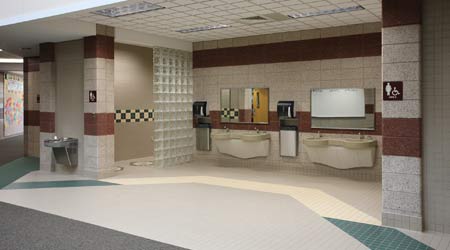 In elementary schools, sinks located in hallway alcoves provide greater visibility of what students are doing and help them move more quickly in and out of the restroom. Photo courtesy of Fanning Howey
In elementary schools, sinks located in hallway alcoves provide greater visibility of what students are doing and help them move more quickly in and out of the restroom. Photo courtesy of Fanning HoweyPrivacy Is Key Concern For School Restrooms
Leaving off doors from restrooms, especially in elementary schools, has pros and cons — facility managers must weigh privacy concerns vs monitoring student activity.
Many school and airport restrooms are designed without doors. Students and visitors instead snake around several walls or partial walls to reach the toilets and sinks. At schools, this allows teachers and staff to keep tabs on activities inside the rooms, even if they’re outside them. This can be important in elementary grades, when an entire class may use the restroom at once, and the teacher has to monitor all restrooms from the hallway. It also can help in middle and high school, when bullying is more of a concern. If there’s no door on the restroom, a teacher standing in the hall may be able to hear when something’s happening that shouldn’t.
Leaving off the doors also eliminates the risk that anyone will be hit by them, Schipp notes. Doors also can make it more difficult for individuals with mobility limitations or those carrying multiple pieces of luggage to enter and exit the restrooms.
When the doors are eliminated, the restrooms must be designed and the mirrors placed so that nobody from outside the room accidentally gains a sightline inside it. Another drawback to omitting doors is that the rooms are more difficult to secure, whether because they’re not needed for a period of time or the facility goes into lockdown. To counter this, some incorporate overhead coiling doors.
Some elementary schools locate hand-washing fountains so they’re open to the hallway. That helps students quickly move in and out of the restrooms.
Maintaining privacy
As restroom privacy becomes a bigger concern, partitions that start four to six inches from the floor and extend to almost to the ceiling are becoming more common. In a recent school retrofit, Schipp’s company included one privacy partition in each restroom. Some schools are installing stalls around urinals, as well.
Rabbeted privacy joints eliminate the quarter-inch gap between the door and sides that occurs with regular partitions, and “offer zero sight line,” Schipp says.
Related Topics:















